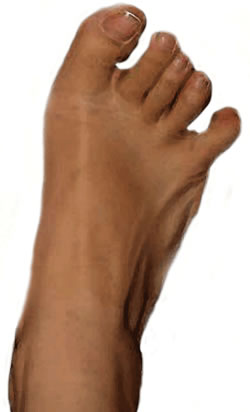Positive Health Online
Your Country

The Little Toe and Beyond
listed in bodywork, originally published in issue 189 - December 2011
The fifth pedal digit or, for you and me, the little toe, would not win a beauty contest. Its colour can vary from pink to blue or even purple. Upon the little toe, chilblains often develop due to circulatory disturbance and corns frequently 'adorn' it. The nail of the foot pinkie is often atrophied when it's not altogether absent. To make matter worst, it rarely stays in good shape to usually end up distorted into what is known as quintus varus: leaning towards its neighbours and turning on its long axis, making its nail looks outward instead of upward. What poor and sad things are our little toes!

Our little toes would not fare better in a fitness contest because it has very limited mobility, especially independent mobility. Try to move them away from the others, in a supine position, and you'll soon be convinced of this last assertion. In this attempt you will certainly find out that many parts of your body will start to move uncontrollably, especially the other toes but also, in some cases, very distal parts such as the hands and/or the head and muscle in the whole leg might contract.
But the little toe usually remains stubbornly disobedient and does not move an inch or, if it does move, it is in other directions than the one intended. Trying to abduct the little toe can be terribly frustrating and irritating. Yet, the human foot is not devoid of an aBDuctor muscle of the fifth toe. Among the intrinsic muscles of the foot there exists the abductor digiti quinti which action is to pull the little toe away from its fellows.
One of the reasons for the lack of mobility in the human little toe is that its last two phalanges are commonly fused together. Interestingly, this synostis is congenital and occurs early in foetal life. This fusion represents an important evolutionary change. We, human beings, do not have the need for grasping movements of the foot and toes which is so important in our cousins the monkeys and apes. This is because we have evolved into a fully erect bipedal animal and, as a result, have developed a foot adapted for this purpose. Functionally speaking, the predominant requirements of the human foot are static stability and active locomotion. The lateral side of the human foot (where the little toe is) has developed in such a way that it became specialized for the stabilized static support of the body weight, and lost in the bargain most of its mobility
It would seem that our diminutive toe is a useless appendage in a state of decrepitude and obsolescence. Not surprisingly, surgeons used to show some disdain towards it and, as a result, did not have much qualm in amputating it. This was a time when the concept of useless or functionless organs was in vogue. Let's hope that we have moved forward in this regard.
Because the human little toe is, in spite of its not very engaging appearance, a valuable part of our body and a distinctive one that deserves some respect.
Francoise Mezieres, the founder of the Mezieres' method, had a lot of interest in the human little toe. She could spend most of a session devoted to try making her patients move, even a fraction, their little toe. Her opinion was that it is abnormal to be unable to abduct one's little toe and she said that she never saw someone suffering from hip arthrosis capable of moving their little toe away from its neighbours.
The followers of Mezieres know that asking a patient to try to abduct his or her little toe while the other toes are maintained in their proper shape and prevented from moving unduly is a very useful manoeuvre to treat some musculo-skeletal disorders and physical distortions, in particular hallux valgus (a condition where the big toe is drawn towards the lesser toes, often accompanied by bunions).
A common deformity of the front foot is one where the metatarsal bones of the first and fifth toes rotate axially towards each other. This provokes a 'collapse' of the transversal arch of the foot and the misalignment of the first and fifth toe (hallux valgus of the big toe and quintus varus of the fifth). It's like if the big and small toes are attracted towards each other, resulting in a somehow pointed shape of the front of the foot. It's handy (so to speak) if you like wearing pointy shoes, but you don't depart from normal shape without paying the consequences.
For a start, these deformations compromise normal walking since the push off phase of walking given by the attempted flexion of the toes, and most particularly the big toe, is practically lost. Besides the aesthetic aspect, the hallux valgus condition of the big toe is also the cause of bunions which can be a source of pain. Furthermore, the sinking of the transversal arch put the metatarsal heads under a lot of pressure, giving rise to callosities that also can become the cause of serious pains. All of these deformities are caused by the shortening of some groups of muscles.
Evolution works slowly. In spite of the human trend towards a reduced mobility of the little toe, the ability to abduct it should be regarded as physiological (normal). Trying to move it in a controlled and assisted way during a Mezieres' session proves to be an efficient therapeutic procedure that works towards regaining a normal tone in the muscles that have distorted the foot.
Comments:
-
No Article Comments available